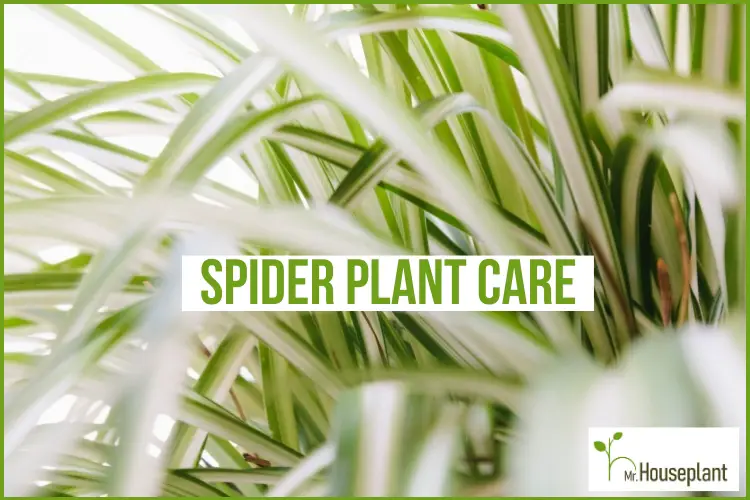
Are you having problems with your spider plant care routine? Is the plant struggling? Or perhaps it’s doing ok, but you would like it to be more lush? Maybe you’re struggling with brown leaf tips? Read on for this information and much more.
| Botanical Name (Latin Name/Scientific Name): | Chlorophytum comosum |
| Common Name: | Spider plant |
| Light: | medium light (1,000 lux – 2,500+ lux) |
| Watering: | when the soil dries out to the bottom of the pot |
| Soil: | well-draining |
| Repotting: | once a year |
| Temperature: | 65°F to 75°F (23°C to 18°C) |
| Humidity: | 25% to 50% but adapts well to any humidity |
| Toxicity for Pets: | Non-Toxic |
| Toxicity for Humans: | Non-Toxic |
| Propagation: |
|
| Pruning: | Prune dead or diseased growth or when you want the plant to branch out |
Light Requirements
| Minimal amount of light: | 1,000 lux (100 FC) |
| Optimal amount of light: | 2,500+ lux (250+ FC) |
| Direct sun tolerance: | 3-4 hours |
| Category: | medium light |
Proper light conditions are the most important for Spider Plants. Spider Plants need medium indirect light (a minimum of 1,000 lux or 100 foot candles). If you can provide them with bright indirect light (over 3,000 lux), even better. More light means the plants will photosynthesize more and be less prone to pests and diseases.
Like all houseplants, Spider Plants will grow well under grow lights.
My current Spider Plants are under a grow light for 10 hours per day, and get an equivalent of 10,000-20,000 lux, which is considered bright indirect light.
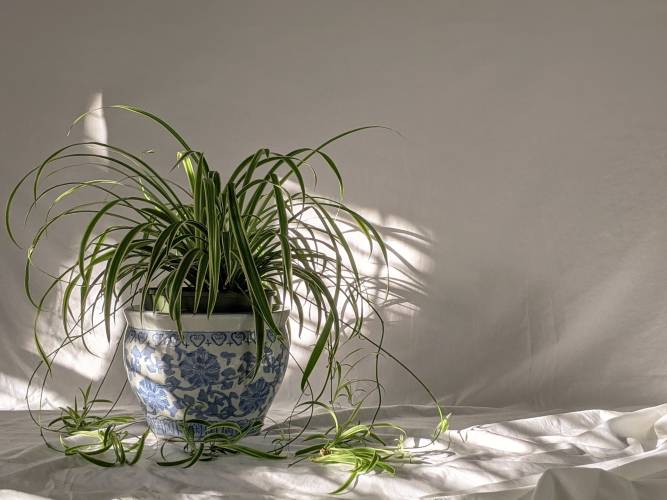
A spider plant in the afternoon light
Although a Spider Plant can take a decent amount of direct sunlight, be aware that the more sunlight it gets, the faster its soil will dry out.
Water Needs
Spider Plants prefer to be on the dry side, so water them once the soil is completely dry, all the way to the bottom of the pot. The frequency of watering will always depend on the amount of light a plant gets — the more light it gets, the more frequent watering it will need.
Other factors to consider are the plant size, potting mix, pot type, humidity and others. Bigger plants will lose more water through the leaves than smaller plants through a process called transpiration, which means the soil will dry out faster. If lower humidity, transpiration increases so the soil will dry out faster then in places with high humidity.
How does a potting mix affect frequency of watering? If you use a potting mix straight out of the bag, it will most likely retain a lot of water and will take a long time to dry out. But if you amend it with things like perlite, bark, pumice or another amendment, the soil will be more porous (which is good as there will be more oxygen for the roots), and it will retain less water, meaning it will dry out faster.
And how does a pot type affect the watering frequency? Terracotta pots absorb moisture from the soil, making it dry out faster, whereas plastic and glazed ceramic pots keep the moisture within the soil.
I don’t recommend having a fixed watering schedule, not only for this but for any of your houseplants. As a general rule, I recommend always checking the soil before watering. For Spider Plants specifically, I recommend waiting until the soil gets completely dry at least half way down the pot. If unsure, wait a few more days, and then water.
If the soil is too dry, Spider Plant will show it by getting droopy. And some species will turn from dark green to light green color. If you want to help the soil dry out quicker, I recommend using a terracotta pot instead of a plastic one.
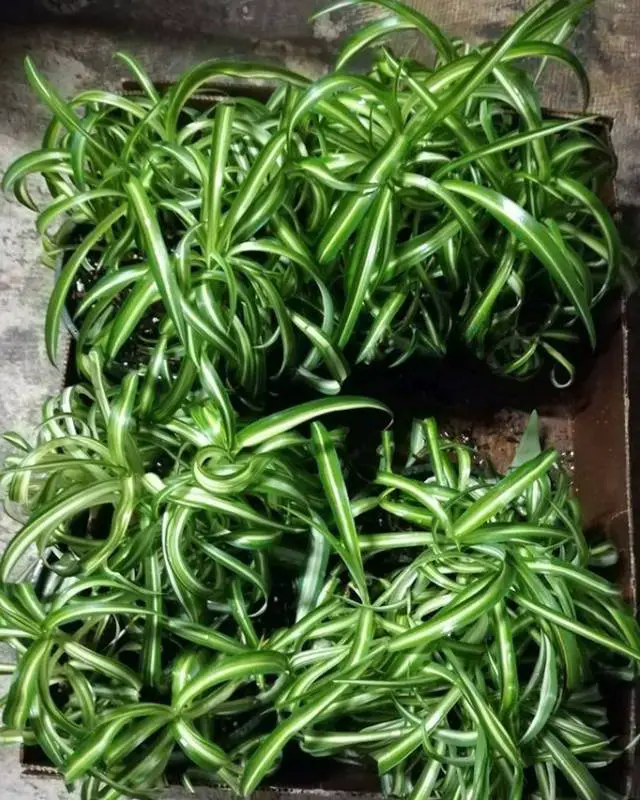
Recovered Spider Plants
Humidity Needs
The average, ideal humidity levels for Spider Plants can go from 25% to 50%. Higher than 50% is also fine. However, like most of the other houseplants, Spider Plants don’t care a lot about humidity, as they adapt very well to low humidity levels, so humidity is not something you need to worry about.
Temperature Requirements
Ideal temperatures for Chlorophytum comosum houseplants are between 65°F (18°C) and 75°F (23°C).
Fertilizing
If you repot your Chlorophytum comosum annually, you don’t need to fertilize it at all. Fresh soil will provide new nutrients, so generally, there won’t be a need to fertilize. Spider Plants in general don’t need a lot of fertilizer, so you’ll be okay with repotting once a year. But if, for any reason, you decide not to repot, feel free to fertilize the houseplant as long as it’s growing because it will be using nutrients from the soil. If the plant stops growing (because of lack of light during wintertime and/or lower temperatures for example), do not fertilize. It won’t be using the nutrients from the soil and there will be a risk of damage from excess fertilizer.
If you wonder what fertilizer to use, I recommend the Sill fertilizer. It has a great N-P-K ratio of 9-3-6, which is excellent for all foliage plants.
Soil
Any tropical mix is fine, as long as you amend it with some perlite and bark or another amendment. I make my own out of any tropical mix but you can also buy MotherEarth GroundSwell; it’s good to use straight out of the bag.
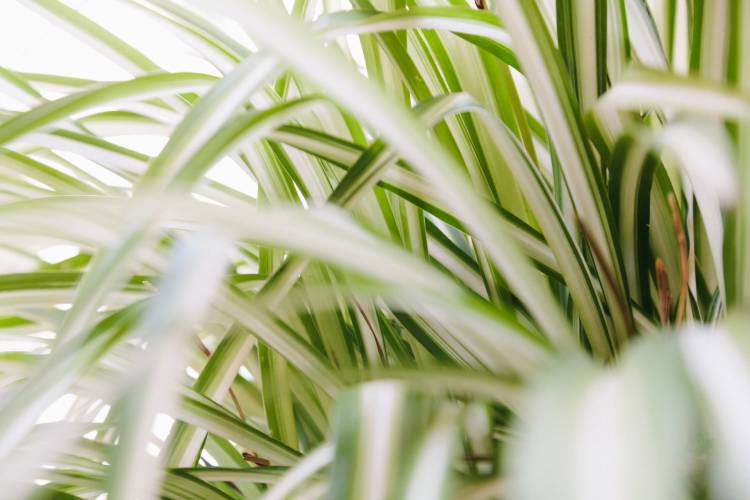
Close-up of a Spider Plant
Repotting
This is how you will properly repot your String of pearls.
- Make a potting mix — 1 part potting soil, 1 part perlite, 1 part bark or buy a ready-to-use MotherEarth GroundSwell potting soil. Mother Earth doesn’t need amending.
- Select an appropriate pot by getting the next pot size, usually an inch or two larger. If your plant is in a 4” pot, get a 6” one.
- Use the flat end of a repotting rake to separate the soil from the pod edges, take the plant out of its pot and then use the other end of the repotting rake to loosen the rootball, and untangle the roots.
- Fill ⅓ of the new pot with soil, put the plant in, and fill the remaining space with soil.
- Press the soil around the plant firmly and water thoroughly, so the soil can settle down and get in contact with the roots.
- After watering, you will see bubbles, because the soil is settling down after watering and the excess air is coming out to the surface. You will see how the soil level goes down after watering, as the soil gets in better contact with the roots.
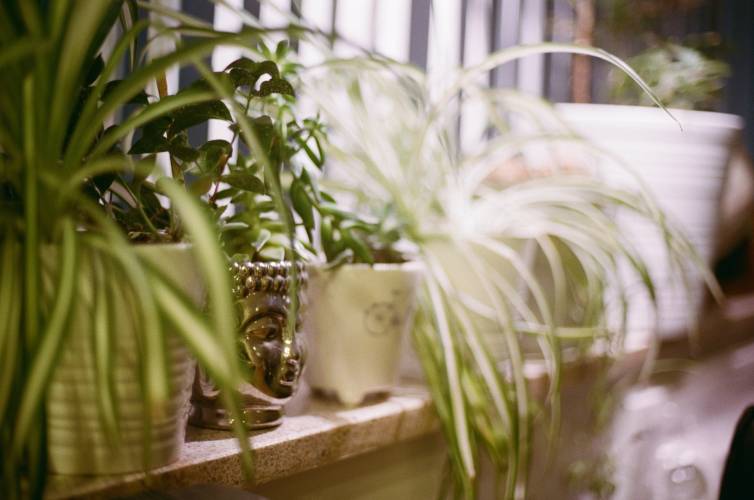
Spider Plants on a window ledge
Get more information on How to Repot Houseplants (Properly).
Toxicity To Humans
Spider Plant is non-toxic to humans. However, California Poison Control System (CPCS) warns that non-toxic plants can also cause vomiting in humans if ingested.
Toxicity To Pets
Spider Plant is non-toxic to pets according to the American Society For The Prevention Of Cruelty To Animals (ASPCA). Still, there is a possibility even for non-toxic plants to cause vomiting in animals, as confirmed by the California Poison Control System (CPCS).
Pruning
You can prune Spider plants to remove dead brown leaves. Or if the plant is overgrown and you want it to take up less space. To prune use a pair of clean, sharp scissors or pruning shears. Sterilize them before using. If the plant has dead leaves (brown and dry), trim those leaves off at the base.
Propagation
Spider plants are among the easiest plants to propagate. They start growing roots in water in a matter of days.
A Spider Plant can grow a long flower stem that will develop tiny Spider Plant babies, plantlets, or so-called spiderettes. These plantlets can be kept on the stem or you can separate them and propagate.
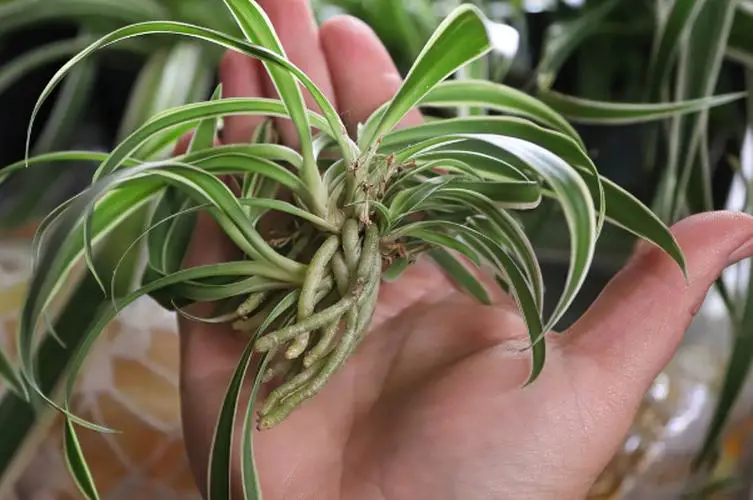
A rooting Spider plant runner
Propagating Spider plants is a pretty straightforward process.
Just pull off one of the babies and put it in water. As the time goes by the level of water will go down. Some of it will be used by the plant, some will evaporate. Make sure to refill regularly so the bottom of the plant is under water and can develop roots. Also replace the water every 1 to 2 weeks. This will replenish oxygen and remove all the anaerobic bacteria from the water and algae. The babies will grow roots very quickly. Once you have an inch of roots, pot into soil.
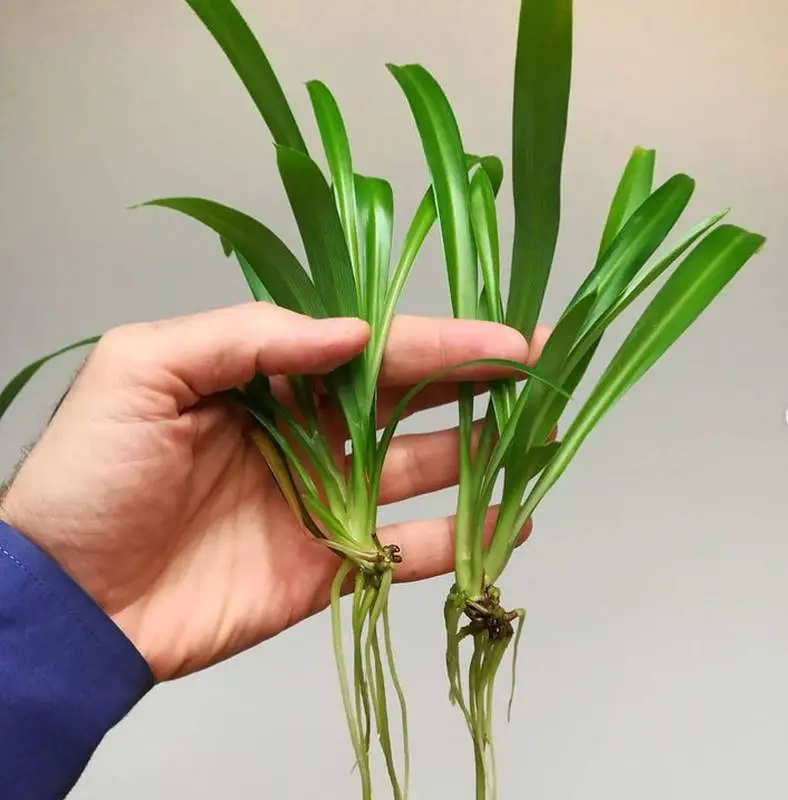
How to propagate a spider plant
The plant in the photo above started growing roots in a few days. I decided to keep mine in the water forever. 😊
You can also put the plantlets in soil as soon as you pull them off the mother and propagate that way. You just need to water them more often, until they grow roots. Cover the plant with a plastic bag or keep it in a humidity dome. This will reduce water loss by the plant and increase chances of successful propagation.
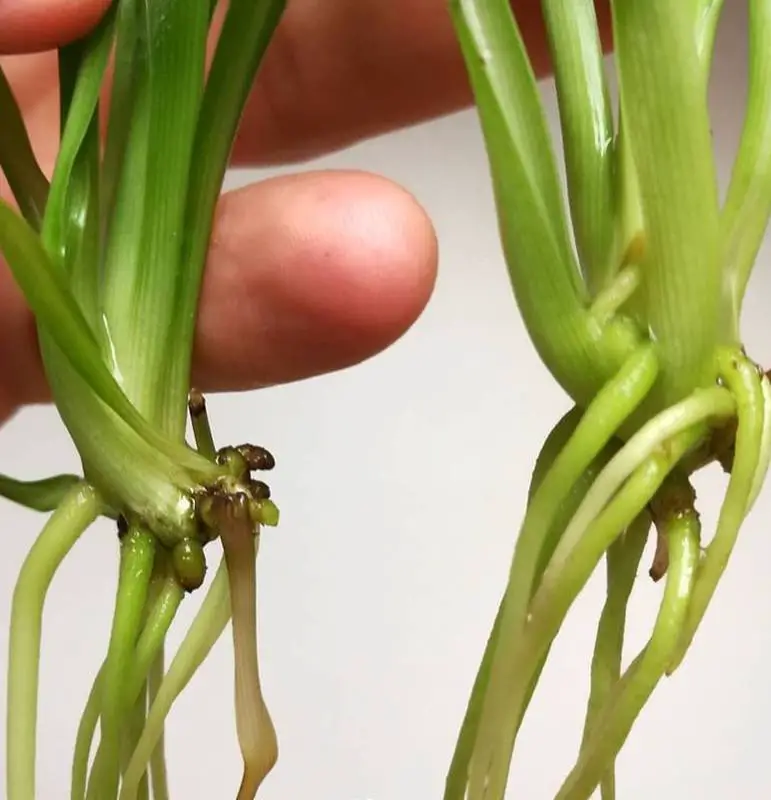
Spider plants roots close up
You can also see the water propagation of Spider Plants in my video below.
FAQ about Spider Plant
My Spider Plant has brown tips. What should I do?
Brown leaf tips on spider plants can be caused by many things. High fluoride in tap water, soil that is too dry or too wet, fertilizer burn or low humidity. Whatever the reason is in your case, brown leaf tips in general on any plant are nothing to worry about. In most cases it’s just a cosmetic flaw, not a sign that something is wrong with the plant
My Spider Plant doesn’t produce shoots and plantlets. What’s wrong with it?
If your Spider Plant doesn’t produce shoots and baby plantlets, there are several possible reasons. It may be because it’s too young, spider plants need to reach a certain level of maturity before they start producing babies. Another reason is that it’s not getting enough light. Without sufficient light, it’s growth will be slow. More light means more photosynthesis and faster growth, so the plants can faster get to the maturity level needed to produce babies.
What are Spider Plant benefits?
Besides its unique beauty, Spider Plant benefits include the ability to clean air and remove toxins. However, in order to do that on a measurable scale, you would need hundreds of spider plants in your home, which you’ll agree is not practical.
Why are the leaves on my Spider Plant fading and losing color?
If your Spider Plant’s leaves fade and lose color, the most likely reasons is because it’s underwatered. Once the soil dries out fully and the plant needs water, it will become droopy and the leaves will turn lighter in color. Once you water it, it will regain its original color.
How long do Spider plants live?
Spider Plants are perennial plants and can live for many years. If they receive good care, they can live more than 50 years and even outlive their human parents. On average, with standard care, Spider Plants usually live about 20 years.
How many Spider Plant varieties are there?
A lot! There are over 200 varieties of Chlorophytum comosum with different leaves, stripes and colors that all fall into one of the three categories — variegated (the most popular), non-variegated, and curly (their color of the leaves is the same as the variegated kind, only they are curled; harder to find).
Is airplane plant and spider plant the same thing?
Yes, Spider Plant is sometimes called Airplane Plant. As a Spider Plant matures, it grows long flower stalks. These flower stalks grow small plantlets. And these plantlets resemble propellers, hence the name Airplane Plant.
Have More Questions about Spider Plant Care?
If you’re having doubts or more questions regarding Spider Plant care, please let me know in the comments below this article. You can also schedule a virtual one-on-one consultation with me and get the help you need.
Always happy to help!
Yours Truly,



Related Posts
Sansevieria Black Gold (Snake Plant Care GUIDE!)
Spathiphyllum Sensation (FULLY Explained!)
Alocasia Stingray Care